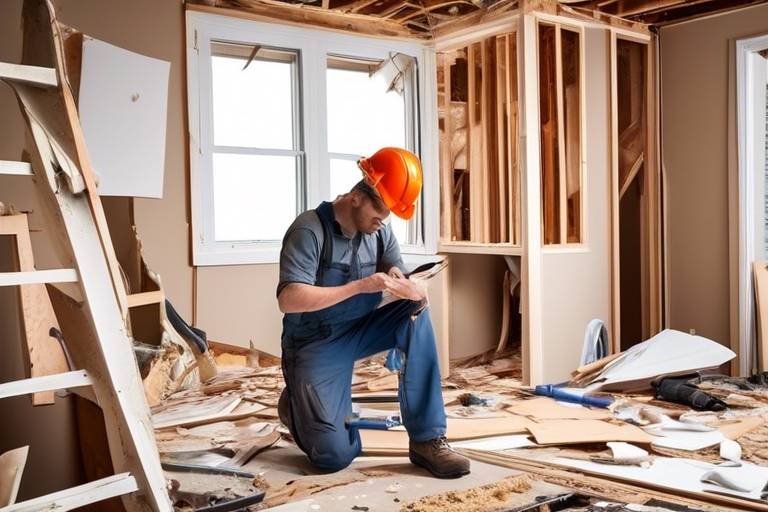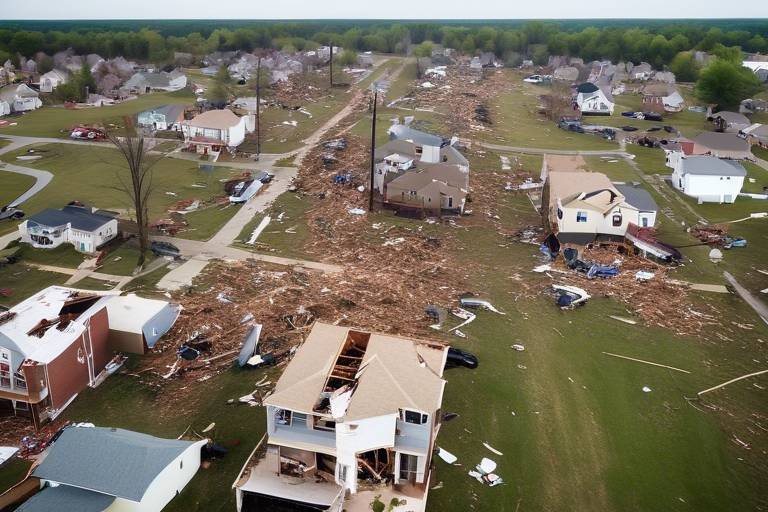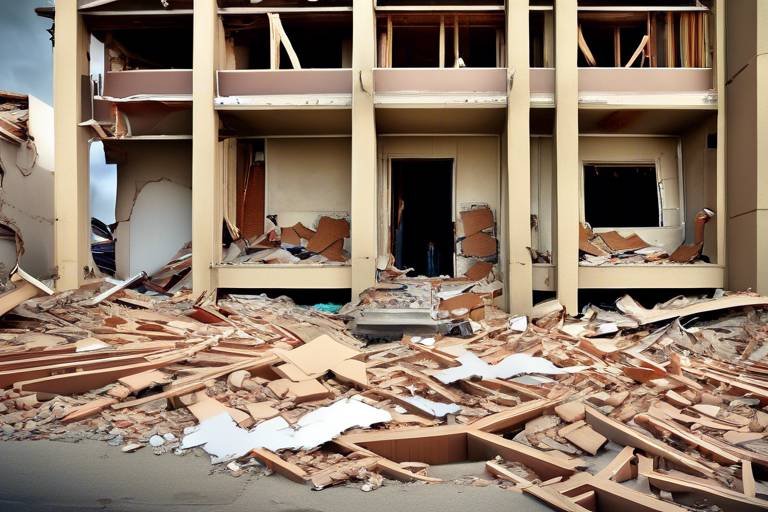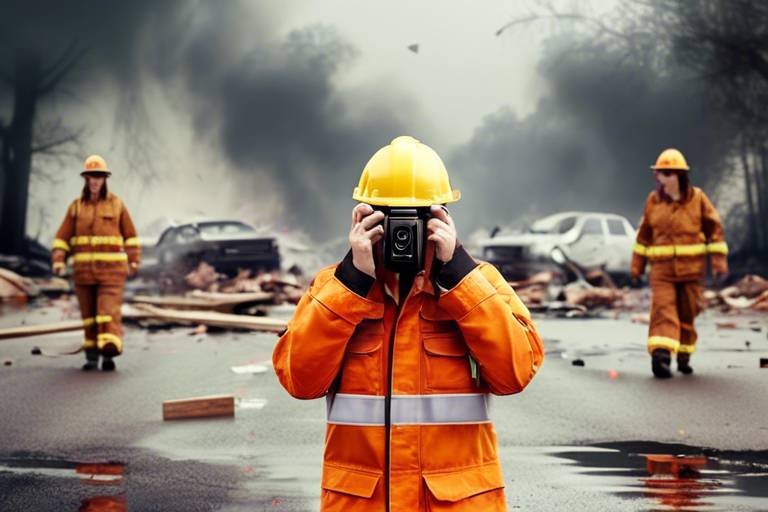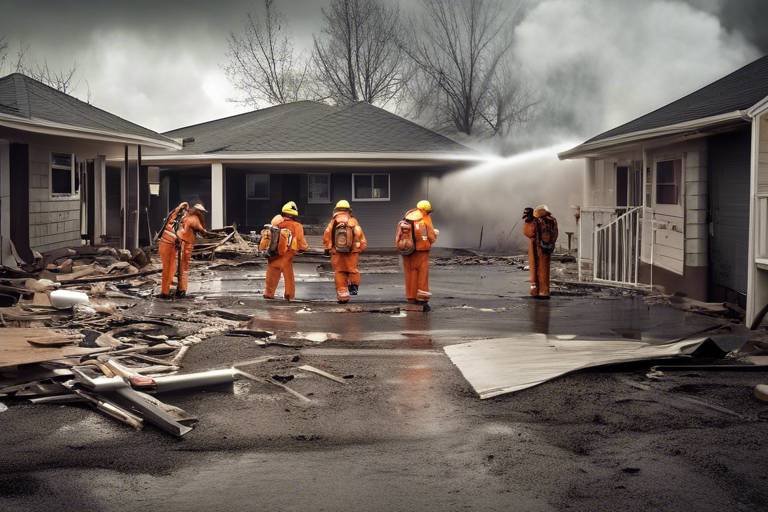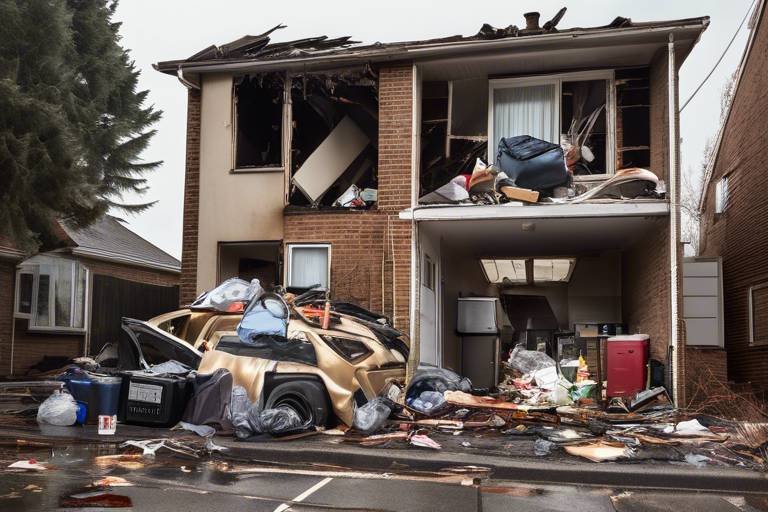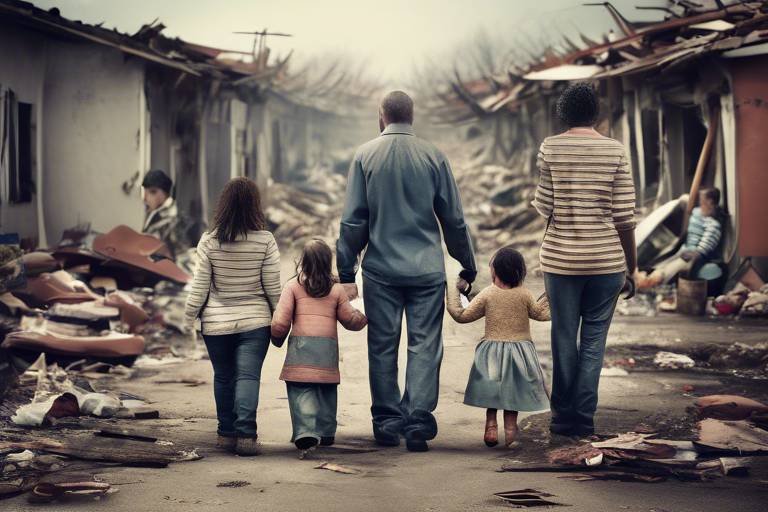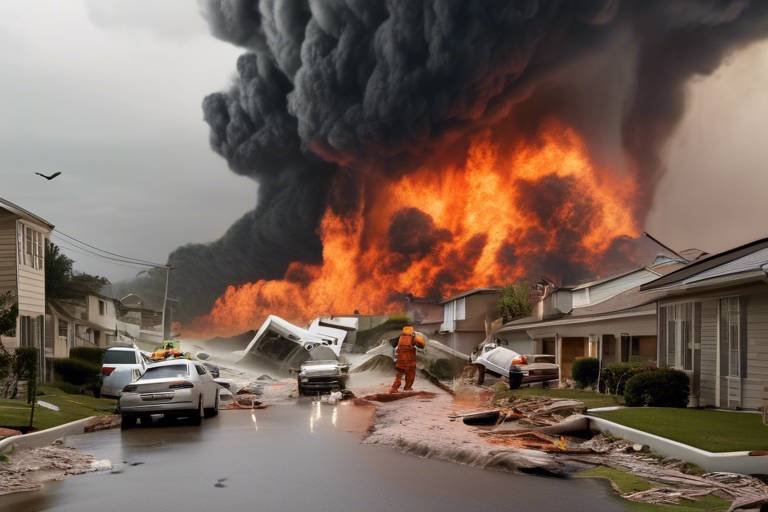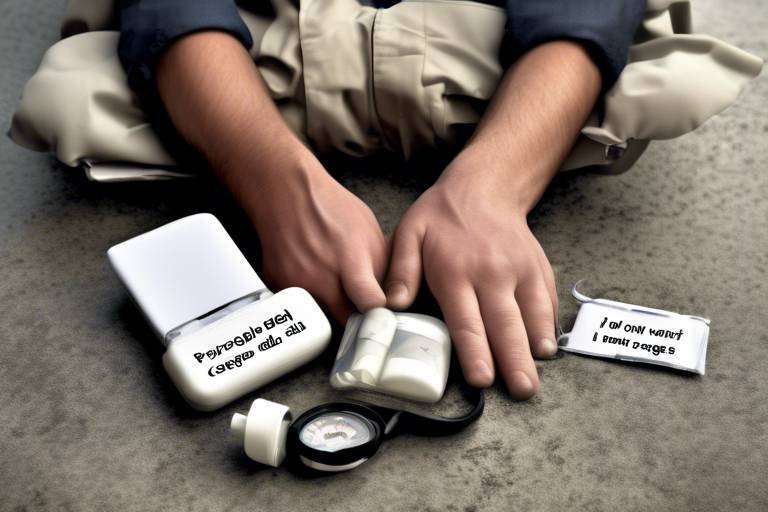Repairing Your Home After a Disaster
Experiencing a disaster can feel like a whirlwind of chaos, leaving you overwhelmed and unsure of where to turn. Whether it’s a natural disaster like a hurricane, flood, or fire, the aftermath can be daunting. However, understanding the essential steps for repairing your home can help you regain a sense of normalcy and control. In this article, we will explore the crucial aspects of assessing damage, creating a repair plan, navigating insurance considerations, and addressing the emotional recovery that follows such events.
Before diving into repairs, it's vital to take a step back and assess the damage thoroughly. This process is akin to a detective investigating a scene—every detail matters. Start by looking for immediate hazards like exposed wiring, gas leaks, or structural instability. Safety first! You wouldn’t want to put yourself or your loved ones in harm’s way while trying to restore your home. As you walk through your space, take notes and photographs to document everything you find. This will be invaluable later on, especially when dealing with insurance claims.
Once you’ve assessed the damage, it’s time to create a comprehensive repair plan. Think of this as your roadmap to recovery. Start by identifying the key components of your plan:
- Timelines: Establish realistic timelines for each phase of the repair process.
- Budge: Determine your budget, factoring in both immediate and long-term repairs.
- Resources: Identify the tools and materials you’ll need, as well as any professionals you may want to hire.
By outlining these elements, you’ll have a clearer picture of what needs to be done and how to tackle it effectively.
Not all repairs are created equal. Some will demand your attention immediately, while others can wait. Prioritizing repairs is crucial for effective restoration. Focus on safety first—if there are structural issues or hazards, those need to be addressed right away. Then, consider the urgency of other repairs. For example, if water damage is present, you’ll want to act quickly to prevent mold growth. By organizing your repairs based on these criteria, you can ensure that your home is safe and livable as soon as possible.
Some repairs may require immediate attention to prevent further damage. Common emergency repairs include:
- Securing broken windows or doors
- Stopping water leaks
- Restoring power if electrical systems are compromised
Addressing these issues promptly can save you from more significant problems down the line.
While emergency repairs are critical, you shouldn’t overlook long-term repairs. These often involve structural and cosmetic work that may take more time and resources. For instance, if your roof has been compromised, it’s essential to plan for a complete replacement rather than a temporary fix. Additionally, consider how you want your home to look once repairs are complete. This is your chance to make improvements and create a space that feels like home again.
Knowing when to hire professionals can save you time and ensure safety. While some repairs may be manageable on your own, others require expertise. When selecting contractors, look for:
- Licenses and insurance
- References and reviews
- Clear communication and transparency
By choosing qualified professionals, you can rest assured that your repairs will be handled correctly, allowing you to focus on the emotional aspects of recovery.
Navigating insurance claims can be complex after a disaster. It’s essential to communicate effectively with your insurance provider to maximize your coverage for repairs. Start by reviewing your policy to understand what’s covered and what isn’t, as this knowledge will empower you during the claims process.
Proper documentation is essential for insurance claims. Take detailed photographs and create a written record of all damages. This visual and written evidence will support your claim and can help expedite the process. Think of it as your insurance “resume” that showcases the extent of the damage.
Familiarizing yourself with your insurance policy details is crucial. Look for key aspects such as:
- Coverage limits
- Exclusions related to disaster repairs
- Deductibles and how they apply
Understanding these elements can prevent unpleasant surprises when it comes time to file your claim.
Repairing your home is not just a physical endeavor; emotional recovery is equally important. The aftermath of a disaster can leave lasting emotional scars, and it’s essential to address these feelings head-on. Consider coping strategies such as journaling, meditation, or even engaging in creative outlets. Remember, it’s okay to feel overwhelmed; you’re not alone in this journey.
Building a support network can aid in emotional recovery. Reach out to friends, family, and community resources. Sharing your experiences and feelings can lighten the emotional load, making it easier to cope with the challenges ahead. Don’t hesitate to lean on your loved ones during this time.
For some individuals, seeking professional help may be necessary. Counseling and therapy can provide a safe space to process emotions and develop coping strategies. The benefits of talking to a professional can be profound, offering insights and tools that facilitate healing.
Q: What should I do immediately after a disaster?
A: First, ensure your safety and the safety of others. Then, assess the damage and report any hazards. Document everything for insurance purposes.
Q: How can I prioritize repairs?
A: Focus on safety first, addressing structural issues and hazards. Then, consider the urgency of other repairs based on potential for further damage.
Q: When should I hire a professional?
A: If you encounter significant damage or repairs that require specialized skills, it’s best to hire a qualified contractor.
Q: How do I navigate insurance claims?
A: Document all damage thoroughly and communicate clearly with your insurance provider. Familiarize yourself with your policy to maximize your coverage.

Assessing Damage
When disaster strikes, the first step in your recovery journey is assessing the damage. This process is not just about looking around and taking stock; it’s a crucial step that can significantly influence the effectiveness of your repairs and the safety of your home. Imagine walking into a room where everything seems fine, only to discover hidden issues that could lead to bigger problems down the line. Therefore, conducting a thorough assessment is essential.
Start by walking through each room of your home, taking note of visible damage. Look for signs of water damage, structural issues, or any hazards that could pose a risk to your safety. It’s important to check:
- Walls and Ceilings: Look for cracks, stains, or bulging areas that might indicate structural damage.
- Floors: Check for warping or soft spots that could suggest underlying issues.
- Windows and Doors: Ensure they open and close properly and check for broken glass or frames.
- Utilities: Inspect electrical systems, plumbing, and HVAC units for any signs of damage.
While you’re assessing the damage, it’s also crucial to identify any immediate hazards. For instance, if you notice exposed wires or gas leaks, these are situations that require urgent attention. In such cases, prioritize safety by turning off utilities if necessary and evacuating the premises until help arrives.
After your initial walkthrough, it’s wise to document everything. Take photographs of the damage from multiple angles, and note any details that might be important later, especially for insurance claims. This documentation will serve as your evidence when communicating with your insurance provider and planning your repairs.
Once you’ve assessed the visible damage, consider the potential hidden issues. Sometimes, the most significant damage isn't immediately apparent. For example, water might have seeped into walls or under flooring, leading to mold growth or structural weakening. If you suspect hidden damage, it may be worth hiring a professional to conduct a more thorough inspection. They can use tools like moisture meters and thermal imaging cameras to uncover issues that are not visible to the naked eye.
In summary, assessing damage after a disaster is a multi-step process that involves careful observation, documentation, and sometimes professional assistance. By taking the time to thoroughly evaluate your home, you’re setting the stage for effective repairs and ensuring the safety of your living environment.

Creating a Repair Plan
When disaster strikes, the aftermath can feel overwhelming, like standing in the middle of a chaotic storm. However, creating a repair plan can serve as your guiding light, helping you navigate through the tumultuous waters of recovery. The first step in this journey is to take a deep breath and gather your thoughts. What do you need to fix? How long will it take? What resources do you have at your disposal? These questions will shape your plan and set the foundation for a successful recovery.
Start by outlining the key components of your repair plan. Think of it as a roadmap that will lead you back to safety and normalcy. Here are some essential elements to consider:
- Timelines: Estimate how long each repair will take. This helps in setting realistic expectations for yourself and your family. Be sure to factor in potential delays, as they are often part of the process.
- Budget: Determine how much you're willing to spend on repairs. It’s crucial to create a budget that reflects both immediate needs and long-term goals. Don’t forget to include a contingency fund for unexpected costs!
- Resources: Identify what tools and materials you already have and what you’ll need to purchase. This includes everything from nails and paint to hiring professionals for specialized work.
Once you have these components in place, it’s time to prioritize. Not all repairs can be tackled at once, and some may be more urgent than others. For instance, if your roof has a leak, addressing that should be at the top of your list to prevent further damage. On the other hand, cosmetic upgrades can wait until after the essentials are handled. Think of it like triaging in a hospital; you want to save the most critical issues first before moving on to the less urgent.
As you develop your plan, consider using a timeline table to visualize your schedule. This can help you stay organized and keep track of your progress. Here’s a simple example:
| Repair Task | Estimated Time | Budget | Priority Level |
|---|---|---|---|
| Roof Repair | 1 week | $1,500 | High |
| Drywall Replacement | 2 weeks | $800 | Medium |
| Painting | 3 days | $300 | Low |
Remember, flexibility is key. Life is unpredictable, and your repair plan may need to adapt as you uncover more damage or as circumstances change. Keep communication open with your family and any professionals you hire. This ensures everyone is on the same page and helps alleviate stress.
Lastly, don’t forget to take care of yourself during this process. Repairing a home after a disaster is not just a physical endeavor; it can be emotionally taxing as well. Make sure to include breaks in your plan, and don’t hesitate to reach out for support when you need it.

Prioritizing Repairs
After a disaster strikes, the chaos can feel overwhelming, and one of the most significant challenges homeowners face is . It's essential to approach this task methodically to ensure that your home is safe and livable again. Think of it as triaging a patient in a hospital—some issues need immediate attention, while others can wait. The first step is to assess the damage and identify which repairs are critical for safety. For instance, if there are exposed wires or structural damage that could lead to further issues, these should be at the top of your list.
Once you've identified the immediate hazards, consider the urgency of each repair. Not all repairs are created equal. Some might be cosmetic, while others could affect the integrity of your home. For example, if your roof has a significant leak, addressing it quickly can prevent water damage to your walls and foundation. On the other hand, repainting a room can wait. It’s all about balancing the critical needs with what can be postponed without jeopardizing your safety or comfort.
In addition to safety and urgency, available resources play a crucial role in prioritizing repairs. If you have limited funds or time, focus on what can make the most significant impact. A good way to visualize this is to create a repair matrix that categorizes repairs based on their urgency, safety implications, and available resources. Below is a simple example of how you might structure this:
| Repair Type | Urgency Level | Safety Impact | Estimated Cost |
|---|---|---|---|
| Roof Repairs | High | Critical | $2,000 |
| Electrical Issues | High | Critical | $1,500 |
| Wall Repairs | Medium | Moderate | $800 |
| Painting | Low | Low | $300 |
This matrix can help you visualize the repairs that need your attention first. Remember, while it might be tempting to jump into cosmetic fixes that can make your home feel better immediately, focusing on safety and structural integrity should always come first. As you work through these repairs, keep in mind that some repairs might require the expertise of professionals, especially when it comes to electrical and plumbing issues.
Ultimately, prioritizing repairs is about making informed decisions that will lead to a safe and comfortable living environment. It’s a process that requires patience and careful consideration, but taking the time to do it right will pay off in the long run. So, take a deep breath, gather your thoughts, and tackle those repairs one step at a time!
- What should I do first after a disaster? Start by assessing the damage and ensuring your home is safe to enter. Look for immediate hazards like gas leaks or electrical issues.
- How do I prioritize repairs? Focus on safety first, then urgency, and finally, consider your available resources. Use a repair matrix to help visualize your priorities.
- When should I hire a professional? If the repairs involve structural issues, electrical work, or plumbing, it's best to hire qualified professionals to ensure safety and compliance with local codes.

Emergency Repairs
When disaster strikes, the chaos can be overwhelming, and the last thing you want to deal with is the aftermath of damage to your home. are those urgent fixes that need immediate attention to prevent further destruction and ensure safety. Think of it as putting a band-aid on a wound; you need to stop the bleeding before you can think about the long-term healing.
The first step in tackling emergency repairs is to conduct a quick assessment of your home. Look for any immediate hazards such as exposed wires, broken gas lines, or significant structural issues. If you notice any of these dangers, it's crucial to prioritize them. For example, if water is leaking from your ceiling, that’s a clear sign you need to act fast. Not only can water damage worsen over time, but it can also lead to mold growth, which presents additional health risks.
Here are some common types of emergency repairs you might encounter:
- Roof Damage: If shingles are missing or your roof is leaking, temporary tarping can help protect your home until you can arrange for a full repair.
- Water Intrusion: Use a wet/dry vacuum to remove standing water, and if possible, set up fans to dry out the affected areas.
- Broken Windows: Board up any shattered windows to secure your home and prevent further exposure to the elements.
- Electrical Issues: If you suspect electrical problems, turn off the power and contact a professional immediately.
Once you've addressed the most pressing issues, it's time to think about how to handle the repairs. Depending on the severity of the damage, you might be able to tackle some of these repairs yourself, but don't hesitate to call in the professionals when necessary. After all, your safety should always come first.
Keep in mind that while it’s tempting to jump straight into fixing everything, taking a moment to breathe and assess the situation can save you time and money in the long run. The chaos of a disaster can cloud your judgment, so having a clear head will help you make better decisions.
In the aftermath of a disaster, remember that emergency repairs are just the first step in a long journey of recovery. Once the immediate threats are dealt with, you can start planning for more comprehensive repairs that will restore your home to its former glory.
As you navigate this process, don't forget to document everything. Take photos of the damage, keep receipts for any materials you purchase, and maintain a detailed log of what repairs you've made. This will not only help you keep track of your progress but will also be invaluable when it comes time to file insurance claims.

Long-Term Repairs
When it comes to , the journey can feel overwhelming, but taking a structured approach can make the process smoother. After a disaster, your home may have sustained damage that requires more than just a quick fix. Long-term repairs often involve addressing structural issues, restoring vital systems, and enhancing the overall aesthetic of your living space. It's essential to take a step back and evaluate what needs to be done, prioritizing tasks based on their significance to your home’s safety and functionality.
First and foremost, you need to assess the structural integrity of your home. This includes checking for issues with the foundation, walls, and roof. A compromised structure can lead to further complications if not addressed promptly. If you notice cracks in the walls or doors that stick, it’s time to call in a professional to evaluate the situation. Remember, while you might be eager to jump into cosmetic repairs, ensuring that your home is safe should always be the top priority.
Once you have a clear understanding of the structural repairs needed, it’s time to create a comprehensive plan for the long-term repairs. This plan should include:
- Budgeting: Estimate the costs involved in each repair project. It’s wise to allocate some extra funds for unexpected expenses.
- Timelines: Set realistic timelines for each repair task, considering the availability of materials and labor.
- Permits: Check local regulations to determine if you need permits for specific repairs.
Long-term repairs can also encompass upgrading systems in your home, such as plumbing, electrical, and HVAC. These upgrades not only enhance your home’s efficiency but also contribute to its overall value. For instance, if your heating and cooling system is outdated, consider investing in a new, energy-efficient model. Not only will this improve comfort levels, but it can also significantly reduce your utility bills.
As you embark on this journey, don’t forget the importance of cosmetic repairs. Once the structural and system-related issues are resolved, you can shift your focus to aesthetics. This might include painting walls, replacing flooring, or updating fixtures. These changes can make your home feel fresh and inviting again, which is vital for your emotional recovery. Remember that your living space is a reflection of you, and making it beautiful can help restore a sense of normalcy.
Lastly, while tackling long-term repairs, consider the future. Think about how you can enhance your home’s resilience against potential disasters. This could involve reinforcing your roof, installing storm shutters, or landscaping to manage water drainage better. By investing in these improvements, you’re not just repairing your home; you’re also protecting it for years to come.
Q: How do I know if I need to hire a professional for long-term repairs?
A: If you encounter significant structural issues or complex systems like plumbing and electrical work, it’s best to consult with a licensed professional. They can provide expert advice and ensure the repairs are done safely and correctly.
Q: What should I include in my repair budget?
A: Your budget should cover materials, labor, permits, and a contingency fund for unexpected expenses. Be realistic about costs, and consider getting multiple quotes from contractors.
Q: How can I ensure my repairs will withstand future disasters?
A: Invest in quality materials and consider upgrades that enhance your home’s resilience, such as stronger roofing materials or improved drainage systems. Consulting with professionals who specialize in disaster recovery can also provide valuable insights.

Hiring Professionals
When it comes to repairing your home after a disaster, one of the most critical decisions you'll make is whether to tackle the repairs yourself or hire professionals. While DIY projects can be rewarding, some repairs require the expertise of qualified contractors to ensure safety and compliance with building codes. So, how do you know when to call in the pros? It's all about understanding the scope of the damage and the complexity of the repairs needed.
First and foremost, consider the extent of the damage. If your home has suffered significant structural issues, such as a compromised foundation or extensive water damage, it's essential to engage professionals who specialize in these areas. Structural engineers, for example, can assess the integrity of your home and provide recommendations for repairs, ensuring that your home is safe for you and your family.
In addition to structural concerns, think about the type of repairs needed. For instance, if you’re facing electrical or plumbing issues, hiring licensed electricians or plumbers is non-negotiable. Attempting to fix these systems without proper training can lead to further damage or even pose safety hazards. It’s like trying to perform surgery on yourself; it’s best left to the experts.
When hiring professionals, don't just pick the first name you find in a search engine. Conduct thorough research to ensure you choose qualified contractors. Look for those with positive reviews, relevant experience, and proper licenses. You might also want to ask for recommendations from friends or family who have gone through similar experiences. A personal referral can often lead you to trustworthy professionals who will treat your home with care.
Once you have a shortlist of potential contractors, it’s time to conduct interviews. Prepare a list of questions to gauge their expertise and approach. Here are some key questions you might consider:
- What is your experience with similar repairs?
- Can you provide references or examples of past work?
- What is the estimated timeline for the repairs?
- How do you handle unexpected issues that arise during the project?
- What are your payment terms?
Don't forget to obtain multiple quotes before making your decision. This will not only give you a sense of the market rate for the repairs but also help you identify any red flags. If a quote seems significantly lower than others, it may indicate subpar work or hidden costs down the line. Always read the fine print and ensure everything is documented in a contract before work begins.
Lastly, maintain open communication with your chosen contractor throughout the repair process. Regular check-ins will help you stay informed about progress and any potential issues that may arise. Remember, hiring professionals is an investment in your home’s safety and longevity, so choosing the right people for the job is paramount.
- How do I know if I need a professional for my repairs? If the damage is extensive or involves critical systems like plumbing or electrical work, it’s best to hire a professional.
- What should I look for in a contractor? Look for experience, positive reviews, proper licenses, and clear communication.
- How can I ensure I’m getting a fair price? Get multiple quotes and compare them, but also consider the contractor’s reputation and experience.
- What if I have a tight budget? Prioritize essential repairs first and consider tackling cosmetic fixes later.

Insurance Considerations
After a disaster strikes, navigating the maze of insurance claims can feel like trying to find your way out of a labyrinth blindfolded. It's crucial to have a clear understanding of your insurance policy and the steps you need to take to maximize your coverage for repairs. First and foremost, communication with your insurance provider is key. They are your best ally in getting the funds you need to restore your home. However, it’s essential to be prepared and informed before you make that call.
Start by reviewing your policy documents. Familiarize yourself with the specific coverage limits and exclusions that apply to disaster-related repairs. For instance, some policies might cover the cost of temporary housing while your home is being repaired, while others may not. Knowing what your policy entails can save you from unpleasant surprises down the line. Here’s a quick table to help you understand some common insurance terms related to disaster coverage:
| Term | Description |
|---|---|
| Deductible | The amount you pay out-of-pocket before your insurance kicks in. |
| Coverage Limit | The maximum amount your insurance will pay for covered damages. |
| Exclusions | Specific situations or damages that are not covered by your policy. |
| Replacement Cost | The amount it costs to replace damaged items without depreciation. |
Once you're familiar with your policy, the next step is to document the damage thoroughly. Take clear photographs and write detailed notes about what has been affected. This documentation is invaluable when filing your claim, as it provides concrete evidence of the damage. Make sure to store these records in a safe place, preferably both digitally and physically, so you have easy access when needed.
When you contact your insurance company, be prepared to explain the situation clearly and concisely. It’s helpful to have your documentation ready to present. If your claim is denied or you feel that the settlement offered is insufficient, don't hesitate to ask for a review. Sometimes, it takes a little persistence to get the compensation you deserve.
Lastly, keep in mind that timeliness is crucial. Most insurance policies have specific timeframes within which you must file a claim after a disaster. Delaying this process can lead to complications or even denial of your claim. Stay organized, keep track of deadlines, and don’t hesitate to reach out for help if you find yourself feeling overwhelmed.
- What should I do immediately after a disaster? Contact your insurance provider to report the damage and start documenting everything.
- How do I know if my claim will be approved? Review your policy for coverage details and maintain thorough documentation of damages.
- Can I appeal a denied claim? Yes, you can request a review of your claim and provide additional documentation if necessary.

Documenting Damage
When disaster strikes, the chaos can be overwhelming, but one of the most crucial steps in the recovery process is documenting the damage. This process not only helps you keep track of what needs to be repaired but also plays a vital role in filing insurance claims. Think of it as creating a visual diary of the destruction, which can significantly aid in communicating with your insurance provider.
Start by taking clear, detailed photographs of all affected areas. Ensure that each photo captures the extent of the damage, including close-ups of specific issues like cracks, water damage, and any structural concerns. If possible, use a camera with a high resolution, as this will provide better clarity when you need to present your case. Remember, a picture is worth a thousand words, and in this scenario, it could be worth thousands of dollars!
In addition to photographs, you should also maintain a written record of the damage. This can include:
- A detailed description of each damaged item or area.
- The estimated cost of repairs or replacements.
- The date and time when the damage occurred.
- Any relevant receipts for repairs already undertaken.
Once you've gathered your documentation, organize it systematically. You might consider creating a digital folder or a physical binder that contains all your evidence. This organization will make it easier when you start the claims process. Additionally, it’s wise to back up your documentation in the cloud or on an external drive to prevent any loss of information.
Finally, as you document the damage, keep a log of all communications with your insurance company. Record the dates, times, and details of conversations, including the names of the representatives you speak with. This will not only help you stay organized but also provide a solid foundation if you need to escalate your claim or dispute any decisions made by the insurance company.
In summary, effective documentation is a vital part of the recovery process after a disaster. It empowers you to advocate for yourself and ensures that you have the necessary evidence to support your insurance claims, making it a step you cannot afford to overlook.
Q: What should I document first after a disaster?
A: Begin by documenting the most severely affected areas. Take photographs and notes of structural damage, water intrusion, and hazardous conditions that pose immediate risks.
Q: How many photographs should I take?
A: Take as many photographs as necessary to capture the full extent of the damage. Ensure you cover all angles and details to provide a comprehensive view.
Q: Is it important to keep receipts for repairs?
A: Yes, keeping receipts for any repairs or replacement items is crucial, as they serve as proof of expenses when filing your insurance claim.
Q: Can I start repairs before my insurance claim is settled?
A: While you can make emergency repairs to prevent further damage, it’s recommended to document the damage thoroughly before starting any non-essential repairs. Always check with your insurance provider first.

Understanding Your Policy
When disaster strikes, the last thing you want is to be left in the dark about your insurance coverage. Understanding your policy is like having a roadmap through a chaotic journey; it guides you on what to expect and what is covered. Start by reading through your policy documents carefully. This can feel overwhelming, but taking the time to familiarize yourself with the details can save you a significant amount of stress later on.
Key aspects to focus on include:
- Coverage Limits: This is the maximum amount your insurance will pay for a covered loss. Make sure you know these limits for both your dwelling and personal property. If the damage exceeds these limits, you could be left footing the bill yourself.
- Exclusions: Every policy has exclusions—specific events or circumstances that are not covered. Common exclusions might include flooding or earthquakes, depending on your location. Understanding these can prevent nasty surprises when you file a claim.
- Deductibles: This is the amount you must pay out-of-pocket before your insurance kicks in. Knowing your deductible helps you prepare financially for repairs.
- Claim Process: Each insurance provider has its own process for filing a claim. Familiarize yourself with the steps involved, including any required documentation or timelines.
It might be helpful to create a summary table of your policy for quick reference. Here’s an example of what that could look like:
| Policy Feature | Details |
|---|---|
| Coverage Limits | $250,000 for dwelling, $50,000 for personal property |
| Exclusions | Flooding, Earthquake |
| Deductible | $1,000 |
| Claim Process | Contact agent within 24 hours, submit documentation |
In addition to understanding the specifics of your policy, don't hesitate to reach out to your insurance agent for clarification. They can provide insights and answer any questions you may have about your coverage. It's better to ask now than to find out later that you were underinsured or misinformed. Remember, your insurance policy is not just a piece of paper; it’s a crucial tool for navigating the aftermath of a disaster.
- What should I do first after a disaster? Assess the damage and ensure your safety before contacting your insurance provider.
- How long do I have to file a claim? This varies by policy, but it's typically within a few weeks. Check your policy for specific timelines.
- Can I hire my own contractors for repairs? Yes, but it's essential to consult with your insurance company first to ensure they approve the costs.
- What if my claim is denied? You can appeal the decision or seek advice from your insurance agent on the next steps.

Emotional Recovery
Repairing your home after a disaster is not just about fixing walls and roofs; it's also about mending the emotional scars that such events can leave behind. The journey of is often overlooked, yet it plays a crucial role in the overall healing process. Think of it as the invisible framework that supports the physical structure of your home. Just as you wouldn't ignore cracks in your foundation, you shouldn't neglect your emotional well-being.
After a disaster, it’s common to experience a whirlwind of feelings—fear, anxiety, sadness, and even anger. These emotions can feel overwhelming, like a storm cloud hanging over your head. However, understanding that these feelings are a normal response to an abnormal situation can help you navigate through them. It's important to acknowledge your emotions rather than suppress them, as this is the first step toward healing.
One effective way to cope with the emotional aftermath is by building a support network. Surrounding yourself with family, friends, and community resources can provide comfort and understanding. Think of them as your emotional safety net, ready to catch you when you feel like you're falling. Engaging in conversations about your feelings can be cathartic, allowing you to process what you’ve experienced. You might find solace in sharing stories, reminiscing about the good times, or simply sitting in silence together.
Additionally, seeking professional counseling can be a valuable resource for those struggling to cope. Therapists and counselors are trained to help you navigate through your emotions and develop coping strategies. They can offer you tools to manage anxiety and stress, giving you a clearer perspective on your situation. Remember, asking for help is a sign of strength, not weakness. Just as you would consult a contractor for structural issues, consulting a therapist for emotional issues is equally important.
Here are some strategies to consider for emotional recovery:
- Practice Self-Care: Engage in activities that promote relaxation and well-being, such as meditation, yoga, or simply taking a long walk.
- Establish a Routine: Creating a daily schedule can provide a sense of normalcy and control amidst chaos.
- Stay Informed, but Limit Exposure: While it’s important to stay updated on recovery efforts, constant exposure to news can increase anxiety. Find a balance that works for you.
Remember, emotional recovery is not a linear process. There will be ups and downs, and that’s perfectly okay. Just as you wouldn’t expect a newly repaired roof to withstand a heavy storm without some reinforcement, don’t expect your emotional state to remain stable without nurturing. By prioritizing your emotional health alongside physical repairs, you set the stage for a more complete recovery.
In conclusion, as you embark on the journey of repairing your home, don’t forget to tend to your emotional garden. Nurture it with care, patience, and love, and you’ll find that both your home and heart can be rebuilt stronger than before.

Support Networks
When disaster strikes, it can feel like the world has turned upside down, leaving you in a whirlwind of chaos and uncertainty. In these challenging times, having a strong support network is crucial for emotional recovery. Think of your support network as a safety net that can catch you when you fall, providing comfort, understanding, and practical help as you navigate the aftermath of a disaster.
Your support network can include a variety of people and resources. Friends and family are often the first line of defense, offering a listening ear or a shoulder to cry on. But don’t underestimate the power of community resources, such as local support groups, churches, or even online forums where you can connect with others who have faced similar challenges. These connections can help you feel less isolated and more understood. After all, sharing your experience with someone who has walked a similar path can be incredibly healing.
Moreover, it’s important to remember that support networks can take many forms. Whether it’s a simple phone call to a friend, joining a local support group, or participating in community activities, each interaction can play a significant role in your recovery. Here are some ways to build and strengthen your support network:
- Reach Out: Don’t hesitate to contact friends and family. They may not know how to help unless you let them know what you need.
- Join Local Groups: Look for community organizations that offer support for disaster recovery. They can provide resources and a sense of belonging.
- Utilize Online Platforms: There are numerous online forums and social media groups where you can share your experience and connect with others who understand what you’re going through.
Additionally, consider participating in community events or volunteering. Engaging with others in a positive environment can help you rebuild your sense of normalcy and foster new friendships. Remember, healing is not just about fixing what’s broken in your home; it’s also about mending the emotional wounds that a disaster can inflict.
In summary, building a robust support network is essential for emotional recovery after a disaster. Whether it's leaning on friends, engaging with community resources, or connecting with others who share your experiences, having that foundation can make all the difference in your journey toward healing and restoration.
Q1: How can I find local support groups for disaster recovery?
A1: You can start by checking with local community centers, churches, or disaster relief organizations. Many have resources or can direct you to support groups in your area.
Q2: What if I feel uncomfortable reaching out to friends and family?
A2: It’s completely normal to feel hesitant. You might start by sending a text or email to let them know you could use some support. Often, people are more than willing to help if they know you need it.
Q3: Are online support groups effective?
A3: Yes! Online support groups can be very effective, especially if you’re unable to attend in-person meetings. They provide a platform for sharing experiences and receiving encouragement from others who understand your situation.

Professional Counseling
After a disaster, the physical damage to your home is only part of the story; the emotional toll can be just as devastating. Many people underestimate how profoundly such events can impact their mental health. This is where comes into play. Seeking help from a licensed therapist or counselor can provide a safe space to process feelings of loss, anxiety, and uncertainty that often arise after traumatic experiences. It’s like having a guiding light in a dark tunnel, helping you navigate through the emotional chaos.
Professional counselors are trained to assist individuals in coping with a variety of stressors, including those stemming from natural disasters. They offer tailored strategies that can help you regain a sense of control over your life. Whether it’s through individual therapy, group sessions, or family counseling, these professionals can help you articulate your feelings and develop healthy coping mechanisms.
Here are a few benefits of engaging with a professional counselor:
- Safe Space for Expression: Counseling provides a confidential environment where you can freely express your emotions without judgment.
- Personalized Coping Strategies: Counselors can equip you with tools and techniques that are specifically tailored to your situation, helping you manage stress and anxiety effectively.
- Support System: Having a professional on your side can make you feel less isolated, offering encouragement and support as you navigate your recovery.
It's essential to remember that seeking help is a sign of strength, not weakness. Just as you would call a contractor to fix your roof after a storm, reaching out to a counselor is a proactive step toward healing your emotional wounds. Many communities also offer resources such as support groups or workshops that can complement individual therapy. These can be invaluable for connecting with others who have faced similar challenges, fostering a sense of community and shared experience.
In conclusion, don’t hesitate to seek professional help if you find yourself struggling to cope after a disaster. The journey to emotional recovery is just as important as the physical repairs you undertake in your home. By investing in your mental health, you’re laying the groundwork for a more resilient future.
- How do I find a qualified counselor? Start by checking local directories, online reviews, or asking for recommendations from friends or family. Look for someone who specializes in trauma or disaster recovery.
- What should I expect during my first counseling session? Your first session will likely involve discussing your current situation and feelings. The counselor will assess your needs and help establish goals for therapy.
- How long does counseling typically last? The duration of counseling varies based on individual needs. Some may find relief in just a few sessions, while others may benefit from longer-term support.
Frequently Asked Questions
- What should I do first after a disaster?
After a disaster, the first step is to ensure your safety and the safety of others. Conduct a thorough assessment of your home to identify any immediate hazards, such as gas leaks or structural instability. Once it’s safe, document the damage before starting any repairs.
- How do I create a repair plan?
Creating a repair plan involves assessing the damage, prioritizing repairs based on urgency and safety, and establishing a budget. Consider timelines for each repair and gather necessary resources. It’s crucial to stay organized to ensure a smooth restoration process.
- When should I hire professionals for repairs?
Hiring professionals is essential when dealing with complex repairs, especially those affecting the structural integrity of your home or requiring specialized skills. If you’re unsure about the extent of the damage or how to proceed, it’s best to consult with a qualified contractor.
- How can I maximize my insurance coverage?
To maximize your insurance coverage, familiarize yourself with your policy’s details, including coverage limits and exclusions. Document all damage thoroughly with photographs and descriptions to support your claim. Communicate effectively with your insurance provider to ensure you receive the compensation you deserve.
- What are some coping strategies for emotional recovery?
Emotional recovery is just as important as physical repairs. Building a support network of friends and family can provide comfort during this tough time. Additionally, consider seeking professional counseling to help navigate the emotional challenges that may arise after a disaster.

